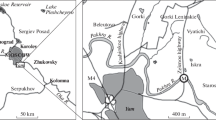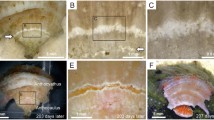Abstract
The widespread lateral attachment in solitary Rugosa (tetracorals) is evidence that their planula settled down and became attached by its ventral side. The symmetry plane of Rugosa corallites, which is marked by the cardinal and counter septa, coincides with the larval plane of symmetry, which is marked by the position of the cardinal septum and attachment scar on the same side of the corallite. This strongly suggests that rugose coral larvae had paired mesenteries at least on the ventral side. Direct or remote soft-bodied rugose coral ancestors had a planula-like body shape and paired ventral and, probably, dorsal mesenteries. They were benthic, crawling on the ventral side, and fed on bottom semi-decomposed organic matter. The study of regeneration in rugose corals has shown that all of three ways of regeneration occur in their skeletons (epimorphosis, morphallaxis, and compensatory regeneration). The morphallaxis is manifested in small buds on dead parent corallites. The study of the development of these buds has shown that their septa were formed under the influence of the surface relief of the parent corallite bearing the bud. At the early stages of bud development, mesenteries were probably absent.
Similar content being viewed by others
References
Agata, K., Saito, Y., and Nakajima, E., Unifying principles of regeneration. I: Epimorphosis versus morphallaxis, Devel. Growth Diff., 2007, no. 49, pp. 73–78.
Batygina, T.B., Embriologiya tsvetkovykh rastenii. Terminologiya i kontseptsii (Embryology of Flowering Plants: Terminology and Concepts), vol. 3 Sistemy reproduktsii (Reproductive Systems), St. Petersburg: Mir Sem’ya, 2000.
Birenhide, R., Haben die rugosen Korallen Mesenterien gehabt?, Senckenb. Lethaea, 1965, vol. 46, pp. 27–34.
Budd, A.F., Romano, S.L., Smith, N.D., and Barbeitos, M.S., Rethinking the phylogeny of scleractinian corals: A review of morphological and molecular data, Integr. Compar. Biol., 2010, vol. 50, no. 3, pp. 411–427.
Dobrolyubova, T.A., Solitary corals of Myachkovian and Podolskian Regional stages of the Middle Carboniferous of the Moscow Region Basin, Tr. Paleozool. Inst. Akad. Nauk SSSR, 1937, vol. 6, no. 3, pp. 5–92.
Dobrolyubova, T.A., The corals Rugosa from the Upper Carboniferous of the Moscow Region Basin, Tr. Paleontol. Inst. Akad. Nauk SSSR, 1940, vol. 9, no. 3, pp. 1–88.
Edwards, H.M. and Haime, J., A Monograph of the British Fossil Corals: Part 1, London: Palaeontogr. Soc. Monogr., 1850.
Elias, R.J., Solitary rugose corals of the Selkirk Member, Red River Formation (late Middle or Upper Ordovician), southern Manitoba, Geol. Surv. Can. Bull., 1981, vol. 344, pp. 1–53.
Elias, R.J., Latest Ordovician solitary rugose corals of eastern North America, Bull. Am. Paleontol., 1982a, vol. 81, pp. 1582–1598.
Elias, R.J., Paleoecology and biostratinomy of solitary rugose corals in the Stony Mountain Formation (Upper Ordovician), Stony Mountain, Manitoba, Canada, Can. J. Earth Sci., 1982b, no. 19, pp. 1582–1598.
Fadlallah, Y.H., Sexual reproduction, development and larval biology in scleractinian corals: A review, Coral Reefs, 1983a, vol. 2, p. 12950.
Gilbert, S., Developmental Biology, 9 ed., Sunderland, Massachusetts USA: Sinauer Ass. Inc. Publ, 2010.
Heltzel, P.S. and Babcock, R.C., Sexual reproduction, larval development and benthic planulae of the solitary coral Monomyces rubrum (Scleractinia: Anthozoa), Mar. Biol. (Berlin), 2002, vol. 140, p. 65967.
Hill, D., Treatise on Invertebrate Paleontology, Part F, suppl. 1 Rugosa and Tabulata, Teichert, C., Ed., Boulder-Colorado-Lawrence, Kansas: Geol. Soc. Am. Univ. Kansas Press, 1981.
Iljina, T.G., Historical development of corals: Suborder Polycoeliina, Tr. Paleontol. Inst. Akad. Nauk SSSR, 1984, vol. 198, pp. 1–184.
Keller, N.B., Glubokovodnye skleraktinievye korally (Deepwater Scleractinian Corals), Moscow: Krasand, 2012.
Kuzmicheva, E.I., Morphology of the skeleton, system, and evolution of scleractinian corals, Tr. Paleontol. Inst. Akad. Nauk SSSR, 2002, vol. 286, pp. 1–212.
Neuman, B.E.E., Some aspects of life strategies of Early Palaeozoic rugose corals, Lethaia, 1988, vol. 21, pp. 97–114.
Oliver, W.A., The relationship of the scleractinian corals to the rugose corals, Paleobiology, 1980, vol. 6, no. 2, pp. 146–160.
Oliver, W.A., Origins and relationships of Paleozoic coral groups and the origin of the Scleractinia, Paleontol. Soc. Pap., 1996, no. 1, pp. 107–134.
Polteva, D.G., Regeneration and somatic embryogenesis in actinians, Tr. Leningr. Ob-va Estestvoispyt., 1972, vol. 78, no. 4, pp. 171–232.
Rozhnov, S.V., Somatic embryogenesis in Bothrophyllum conicum (Rugosa), Paleontol. Zh., 1974, no. 3, pp. 16–22.
Rozhnov, S.V., Development of the trophic structure of Vendian and Early Paleozoic marine communities, Paleontol. J. (Moscow), 2009, vol. 43, no. 11, pp. 1364–1377.
Scrutton, C.T., The Palaeozoic corals: I. Origins and relationships, Proc. Yorkshire Geol. Soc., 1997, vol. 51, no. 3, pp. 177–208.
Scrutton, C.T., The Palaeozoic corals: II. Structure, variation and palaeoecology, Proc. Yorkshire Geol. Soc., 1998, vol. 52, pp. 1–57.
Sorauf, J.E., The coral skeleton: Analogy and comparisons, Scleractinia, Rugosa and Tabulata, Cour. Forschung. Senck., 1993, vol. 164, pp. 63–70.
Stolarski, J., Kitahara, M.V., Miller, D.J., et al., The ancient evolutionary origins of Scleractinia revealed by azooxanthellate corals, BMS Evol. Biol., 2011, vol. 11, p. 316.
Tokin, B.P., Regeneratsiya i somaticheskii embriogenez (Regeneration and Somatic Embryogenesis), Leningrad: Leningr. Gos. Unov., 1959.
Wells, J.W., Scleractinia, in Treatise on Invertebrate Paleontology, Part F: Coelenterata, Moore, R.C., Ed., Boulder-Colorado-Lawrence, Kansas: Geol. Soc. Am. Univ. Kansas Press, 1956, pp. 328–444.
Wells, J.W. and Hill, D., Anthozoa—general features, Treatise on Invertebrate Paleontology, Part F: Coelenterata, Moore, R.C., Ed., Boulder-Colorado-Lawrence, Kansas: Geol. Soc. Am. Univ. Kansas Press, 1956, pp. 161–165.
Yakovlev, N.N., On the morphology and morphogeny of the coral group Rugosa, Izv. St. Peterb. Biol. Lab., 1904, vol. 7, no. 2, p. 87.
Yakovlev, N.N., On the origin of distinctive features of Rugosa, Tr. Geol. Kom., 1910, vol. 66, pp. 1–32.
Yakovlev, N.N., Etudes about the corals Rugosa, Tr. Geol. Kom., 1914, vol. 96, pp. 1–33.
Yakovlev, N.N., On distinctions between the corals Rugosa and Hexacoralla and on the origin of their distinctive features, Ezheg. Vseross. Paleontol. Ob-va, 1937, vol. 11, pp. 41–48.
Yakovlev, N.N., Initial factors in the development of the coral polyps Zoantharia, Dokl. Akad. Nauk SSSR, 1945, vol. 48, no. 6, pp. 460–463.
Author information
Authors and Affiliations
Corresponding author
Rights and permissions
About this article
Cite this article
Rozhnov, S.V. Bilateral symmetry in ontogeny and regeneration of solitary Rugosa (Cnidaria; Paleozoic). Paleontol. J. 48, 1183–1193 (2014). https://doi.org/10.1134/S0031030114110094
Received:
Published:
Issue Date:
DOI: https://doi.org/10.1134/S0031030114110094




